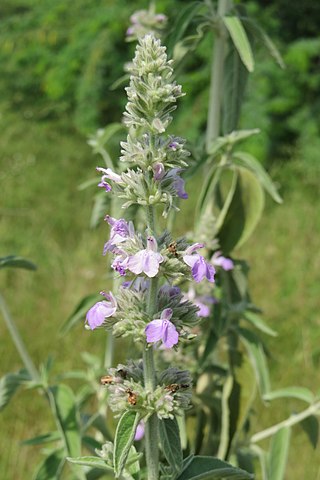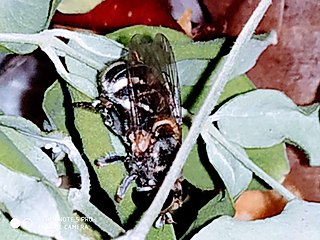
Rambutan is a medium-sized tropical tree in the family Sapindaceae. The name also refers to the edible fruit produced by this tree. The rambutan is native to Southeast Asia. It is closely related to several other edible tropical fruits, including the lychee, longan, pulasan, and quenepa.

A pollinator is an animal that moves pollen from the male anther of a flower to the female stigma of a flower. This helps to bring about fertilization of the ovules in the flower by the male gametes from the pollen grains.

Pollinator decline is the reduction in abundance of insect and other animal pollinators in many ecosystems worldwide that began being recorded at the end of the 20th century. Multiple lines of evidence exist for the reduction of wild pollinator populations at the regional level, especially within Europe and North America. Similar findings from studies in South America, China and Japan make it reasonable to suggest that declines are occurring around the globe. The majority of studies focus on bees, particularly honeybee and bumblebee species, with a smaller number involving hoverflies and lepidopterans.

Couroupita guianensis, known by a variety of common names including cannonball tree, is a deciduous tree in the flowering plant family Lecythidaceae. It is native to lowland tropical rainforests of Central and South America, from Costa Rica, south to Brazil and northern Bolivia and it is cultivated in many other tropical areas throughout the world because of its fragrant flowers and large fruits, which are brownish grey. There are potential medicinal uses for many parts of Couroupita guianensis, and the tree has cultural and religious significance in South and Southeast Asia. In Sri Lanka and India, the cannonball tree has been widely misidentified as the Sal tree, after its introduction to the island by the British in 1881, and has been included as a common item in Buddhist temples as a result.

The pale-billed flowerpecker or Tickell's flowerpecker is a tiny bird that feeds on nectar and berries, found in India, Sri Lanka, Bangladesh and western Myanmar. The bird is common especially in urban gardens with berry bearing trees. They have a rapid chipping call and the pinkish curved beak separates it from other species in the region.

Pancratium is a genus of African and Eurasian perennial, herbaceous and bulbous plants in the Amaryllis family, subfamily Amaryllidoideae

Apis cerana indica, the Indian honey bee, is a subspecies of Asiatic honey bee. It is one of the predominant bees found and domesticated in India, Pakistan, Nepal, Myanmar, Bangladesh, Sri Lanka, Thailand and mainland Asia. Relatively non-aggressive and rarely exhibiting swarming behavior, it is ideal for beekeeping.

Dillenia suffruticosa, also known as simpoh air, simpor, or CB leaf, is a species of Dillenia found in tropical South East Asia in secondary forest and swampy ground. It is a highly invasive weed in Sri Lanka.
Aneriophora is a little-known genus of hoverflies from South America. It contains only one species, Aneriophora aureorufa. The genus was originally named Eriophora by Rodolfo Amando Philippi (1865); this name was preoccupied by EriophoraSimon, 1864, so it was renamed to Aneriophora by Stuardo and Cortés (1952). This species is a specialist pollinator of Eucryphia cordifolia and Laurelia sempervirens.

Anisomeles malabarica, more commonly known as the Malabar catmint, is a species of herbaceous shrub in the family Lamiaceae. It is native to tropical and subtropical regions of India, and Sri Lanka, but can also be found in Malaysia, Bangladesh, Myanmar, Bismarck Archipelago, Mauritius, Andaman Islands and Réunion.

Malabar matthi curry, also known as fish curry, is a traditional Kerala dish. It is usually prepared with fish semi-stewed in a Kerala-style sauce that typically includes a blend of spices and assorted vegetables, such as okra or onions. While sardines are commonly used, the dish can be prepared with a variety of fish, such as mackerel, kingfish, or pomfret. It is usually served with rice or tapioca. The dish is most popular in Kerala, Goa, and Sri Lanka, where rice and fish are staple foods. Other variations may include adding tamarind juice or coconut milk.

Eriogonum argophyllum is a species of wild buckwheat known by the common names Sulphur Hot Springs buckwheat, Silver Lake buckwheat, and Ruby Valley buckwheat. It is endemic to Nevada in the United States, where there is only one known population.

Pseudapis oxybeloides is a species of soil-nesting bee in the genus Pseudapis. of the family Halictidae, and a major global pollinator.
Heriades parvula is a species of leaf-cutting bee in the genus Heriades, of the family Megachilidae. It is also spelled Heriades parvulus. It is a pollinator of Omphalogramma souliei and Teak

The Indian stingless bee or dammar bee, Tetragonula iridipennis, is a species of bee belonging to the family Apidae, subfamily Apinae. It was first described by Frederick Smith in 1854 who found the species in what is now the island of Sri Lanka. Many older references erroneously placed this species in Melipona, an unrelated genus from the New World, and until recently it was placed in Trigona, therefore still often mistakenly referred to as Trigona iridipennis. For centuries, colonies of T. iridipennis have been kept in objects such as clay pots so that their highly prized medicinal honey can be utilized.

Lithurgus is a genus of bees in the family Megachilidae.
Ceratina sequoiae is a species of small carpenter bee in the family Apidae. It is found in North America. It is a specialist on Clarkia flowers.
Aasmi is a traditional Sri Lankan deep-fried sweet snack, which is served on Aluth Avurudda/Puthandu, weddings and birthdays.














